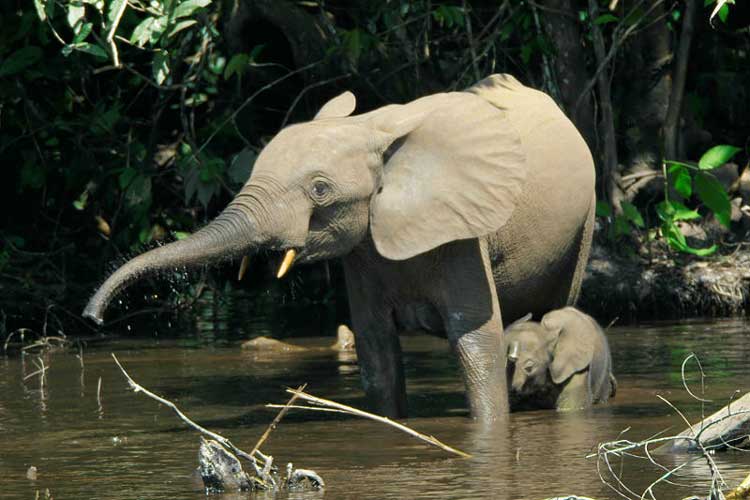Loxodonta cyclotis (*) Cladus: Eukaryota Name Loxodonta cyclotis (Matschie, 1900) Type locality: Yaunde, S Cameroon References * Loxodonta cyclotis on Mammal Species of the World.
The African Forest Elephant (Loxodonta cyclotis) is a forest dwelling elephant of the Congo Basin. Formerly considered either a synonym or a subspecies of the African Savanna Elephant (Loxodonta africana), a 2010 study established that the two are distinct species.[2][3] The disputed Pygmy Elephants of the Congo basin, often assumed to be a separate species (Loxodonta pumilio) by cryptozoologists, are probably Forest Elephants whose diminutive size and/or early maturity is due to environmental conditions.[4] Differences include the African Forest Elephant's long, narrow mandible (the African Bush Elephant's is short and wide), its rounded ears (an African Bush Elephant's ears are more pointed), straighter and downward tusks, considerably smaller size, and number of toenails. The male African Forest Elephant rarely exceeds 2.5 metres (8 ft) in height, while the African Bush Elephant is usually over 3 metres (just under 10 feet) and sometimes almost 4 metres (13 ft) tall. With regard to the number of toenails: the African Bush Elephant normally has 4 toenails on the frontfoot and 3 on the hindfoot, the African Forest Elephant normally has 5 toenails on the frontfoot and 4 on the hindfoot (like the Asian elephant), but hybrids between the two species occur. The African Forest Elephant is an herbivore and commonly eats leaves, fruit, bark, and occasionally visits mineral licks. They eat a high proportion of fruit and are sometimes the only disperser of some tree species such as Balanites wilsoniana and Omphalocarpum spp. Owing to poaching and the high demand for ivory, the African Forest Elephant population approached critical levels in the 1990s and early 2000s.[5][6] Late in the 20th century, conservation workers established a DNA identification system to trace the origin of poached ivory. It had long been known that the ivory of the African Forest Elephant was particularly hard, with a pinkish tinge, and straight (whereas that of the African Bush Elephant is curved). The DNA tests, however, indicated that the two populations were much more different than previously appreciated — indeed, in its genetic makeup, the African Forest Elephant is almost two-thirds as distinct from the African Bush Elephant as the Asian Elephant is. References ^ Shoshani, Jeheskel (16 November 2005). "Order Proboscidea (pp. 90-91)". In Wilson, Don E., and Reeder, DeeAnn M., eds. Mammal Species of the World: A Taxonomic and Geographic Reference (3rd ed.). Baltimore: Johns Hopkins University Press, 2 vols. (2142 pp.). p. 91. ISBN 978-0-8018-8221-0. OCLC 62265494. IUCN African Elephant Specialist Group (AfESG): Statement on the Taxonomy of extant Loxodonta (February, 2006). Source: Wikipedia, Wikispecies: All text is available under the terms of the GNU Free Documentation License |
|


